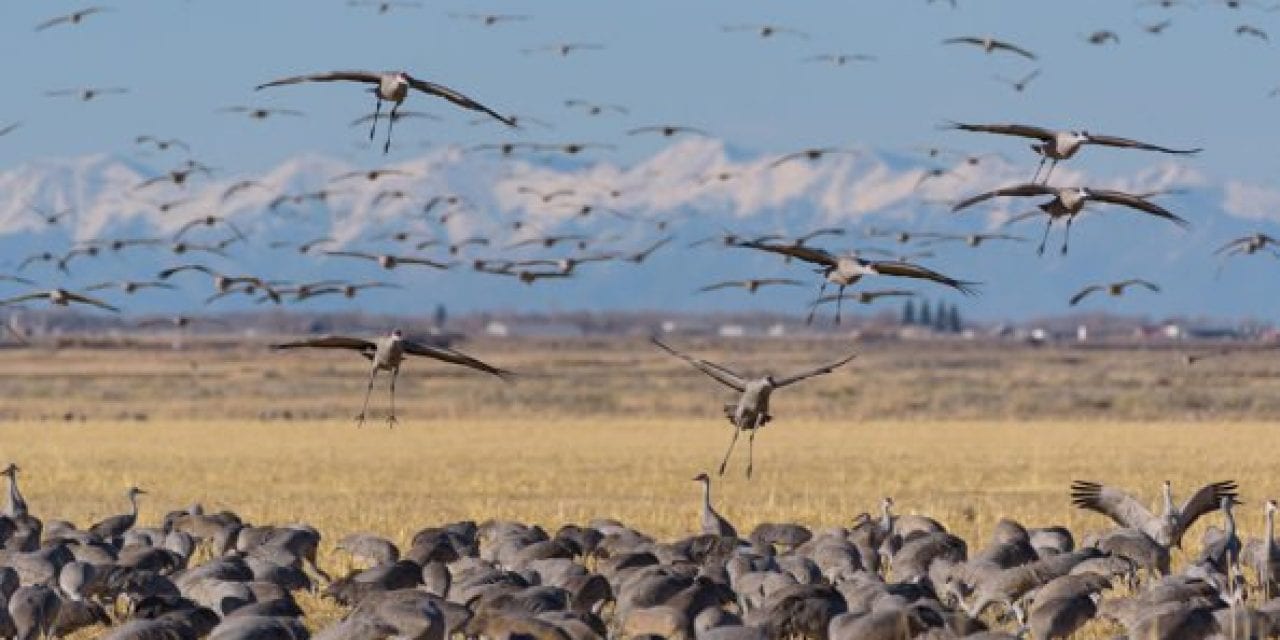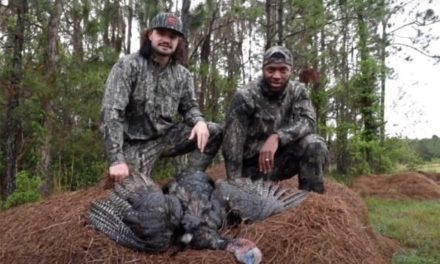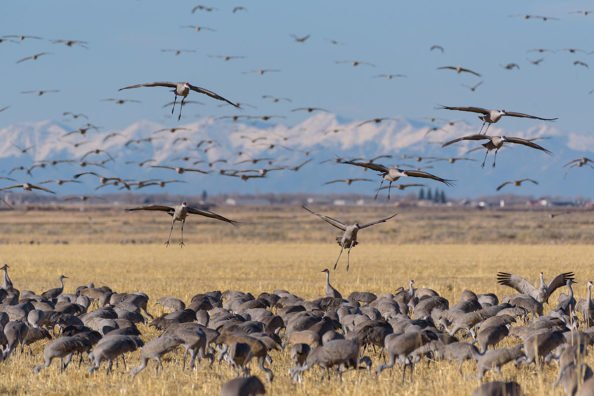
Here’s what you should keep in mind for Sandhill crane hunting gear, strategy, and tactics.
Have you ever seen a few Sandhill cranes gliding through the autumn sky? Did you know hunting them has become more and more popular by the season?
These amazing birds with their distinctive cries might be best described by hunters as the “ribeye of the sky.”
If you’re looking to get started or just learn as much as you can, here’s what’s involved in sandhill crane hunting.
Sandhill Crane Biology
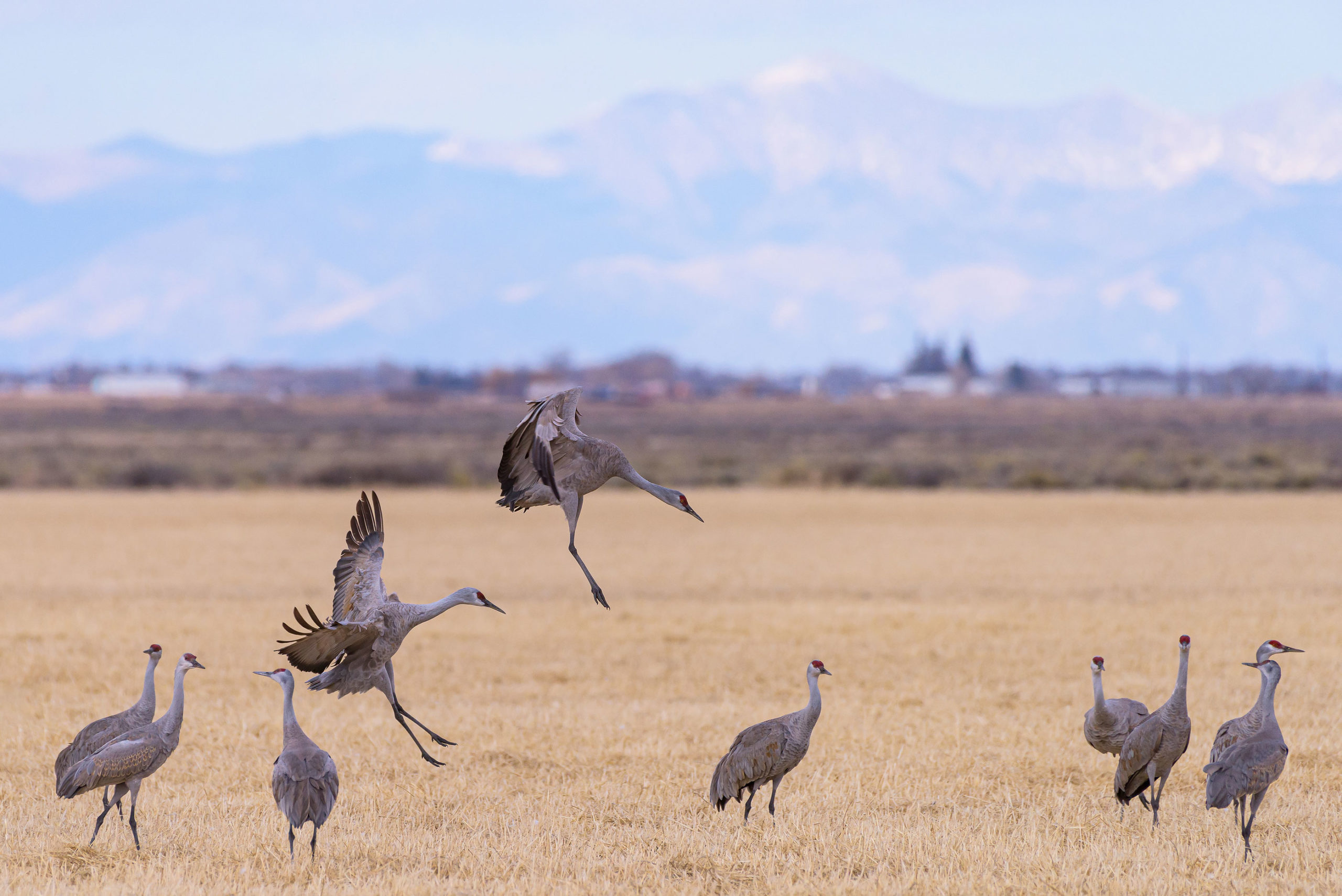
The Sandhill crane is best described by the bird watching enthusiasts at All About Birds who say, “These tall, gray-bodied, crimson-capped birds breed in open wetlands, fields, and prairies across North America.”
It should be noted right at the start that these migratory game birds are similar to the endangered whooping cranes, but it should be easy to distinguish between the two. The whooping crane and Sandhill crane are related, but as Kansas Trail Guide says, “While both species have long necks, long, black legs, and long, straight bills (they are both crane species after all), there are some key but sometimes subtle differences.” Maybe the most obvious difference is that “whoopers” are pure white and much larger than their cousins, the Sandhill crane. Sandhills are also commonly mixed up with great blue herons.
A slate gray color and a small red cap are the typical adult Sandhill crane features. They’re, on average, about four and a half feet tall.
The Sandhill crane breeds in much of northern North America and especially in the American mid-west region, which is a key staging area for the birds. These birds mostly use the Central Flyway to migrate south to Texas, New Mexico, and into Mexico itself, but they sometimes use the Mississippi Flyway with populations reaching all the way to Florida and Cuba.
Sandhill cranes are known for their incredible courtship dances during which they stretch their wings, pump their heads, bow, and leap into the air like some kind of avian Lords of the Dance. Sandhill cranes mate for life, which may be no wonder since they put on such a show for a potential partner. Their longevity can last 20 years sometimes. The oldest recorded Sandhill crane was a bird that was tagged in Wyoming in 1973 and found in New Mexico in 2010!
As hunters, we never shy away from the opportunity to learn more about our favorite wild game and the Sandhill crane is no exception. But now it’s time to dispense with the pleasantries and take a look at hunting these magnificent birds.
Sandhill Crane Hunting
First off, and depending upon where you will be hunting, you will need a Migratory Game Bird Endorsement, Federal Sandhill Crane Permit, and a Federal Duck Stamp. In most places, the HIP Certification is also required.
Hunting opportunities and access varies but is growing, especially in parts of the southern U.S. In fact, in January, 2020, the state of Alabama hosted its first Sandhill crane hunting season in over 100 years, a testament to hunters seeing increased numbers of Sandhills in the field while duck hunting. In Texas alone, 192 out of 254 counties have an open Sandhill crane hunting season.
In total, there aren’t many states that have open Sandhill crane hunting seasons. Among those that do are Colorado, Wyoming, Kansas, Montana, Oklahoma, Texas, Utah, Idaho, Minnesota, Arizona, Tennessee, Kentucky, Alaska, New Mexico, North Dakota, and South Dakota. According to the U.S. Fish & Wildlife Service, Nebraska is the only Central Flyway state that does not have an open season on Sandhill cranes.
Wildlife Management Areas and Federal Wildlife Refuges will have specific regulations requiring nontoxic shot for all migratory game bird hunting, including Sandhill cranes, so it pays to know your area and its specific regulations.
Believe it or not, Sandhill cranes are known as a somewhat dangerous species for hunters. It’s easy to assume their down and out after getting shot, only to approach the birds and have them jump back to life.
In some cases they even fight back.
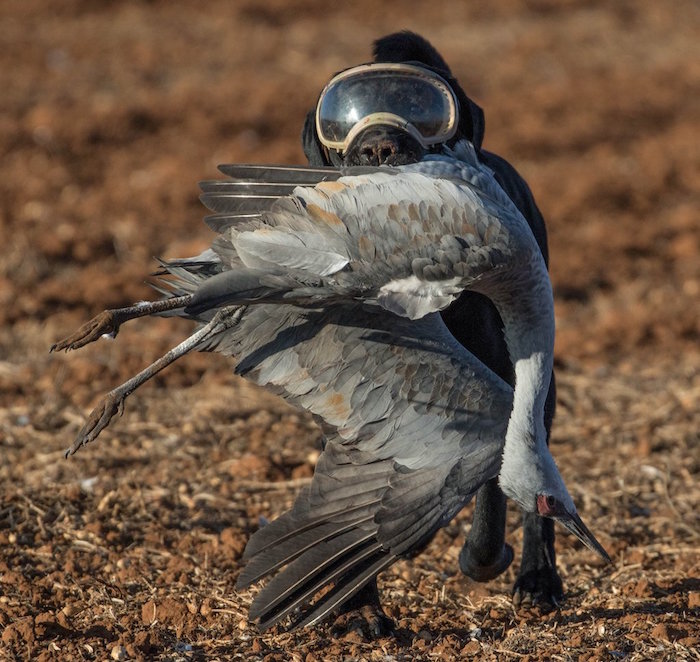
Sometimes their massive claws or sharp beaks can be a big problem for a retrieving dog, which is why companies like Rex Specs now offer eye protection for bird dog owners.
Hunting Strategy
Cranes typically rest in sloughs, flooded fields, and shallow marshes, but love to feed in recently cut agricultural fields.
Sound familiar? As with the many other species of waterfowl that they migrate with, Sandhills will come off of the roost to feed, particularly in the morning.
Unlike duck and goose hunting, open water is usually not the place to set up, and finding fields that are being used by cranes is the first order of business. This can be done by pre-season scouting, but the fact remains that these birds move around a lot. You may simply need to chase them down via the road, and luck out with permission to hunt a few target fields.
It’s not scientific, but many Sandhill hunting veterans will tell you that these long-lived, long-legged birds have eyesight akin to a hawk, or dare we say it, a wild turkey. This puts the emphasis on concealment when setting up the blind and the use of full-body, high definition decoys, and a well-trained, well-hidden hunting dog to defeat not only their eyes, but their intelligence as well.
One good thing when hunting these birds is that the tools remain mostly the same. Many simply use a good 12 gauge shotgun, usually with a modified choke, and loaded with 3″ number two steel shot.
Not all states require non-toxic ammunition for Sandhills. In Texas, for one, hunters may use lead shot for Sandhill crane hunting. Be sure to check your local regulations before heading to the ammo aisle.
Bag limits are in the range of 2-3 birds per hunter per day depending on the state or region that you wish to hunt, and possession limits are in the 9-10 range. You will certainly have to register your successful harvest with the Harvest Information Program following your hunt.
Sandhill Crane Hunting Gear
One good thing about hunting cranes is the fact that you can use pretty much what you would use for any standard waterfowl hunt, with a big exception: the decoys are fairly pricey.
Depending on what company you will buy from, a simple six pack of full-body crane decoys will run you nearly $500, a three pack half of that, and a call alone could cost you up to $150. There are less expensive alternatives as well, but with Sandhill crane hunting, you get what you pay for.
Camouflage is best when it blends you in with the natural surroundings that you will be hunting, so consider if you need a timber, a prairie, or a marsh pattern. You will also need to have waterproof boots and insulated gloves especially if you will be in a lay out blind. Eye and ear protection is always a good idea as well.
Tactics
As with any field hunt for migratory game birds, arranging your decoys according to the wind direction is a must, and numbers are everything sometimes 6-8 dozen are required for a convincing set up. Many veteran crane hunters say that while a good spread of goose decoys makes for a good set up, Sandhill cranes are known to avoid them if they outnumber your crane dekes.
Just like with hunting most flocking birds, hunts can be set up for pass shooting or for decoying. For pass shooting birds, playing the wind direction is a must, and creating a long perpendicular (head on) pocket towards the hunters for the birds to glide into. This can be encouraged by having the wind at about 45 degrees to the shooters.
That approach gives cranes a chance to show that they will either readily decoy or get close enough for shots. Either way is a great way to hunt Sandhills.
As with any hunt, license holders need to know their hunting regulations and have the correct hunting permits based on their state’s Department of Natural Resources or other agency.
Seasoned sandhill crane hunters know full well how difficult a crane hunt can be, but also how rewarding it is when things come together. The only thing left to decide: are you ready to eat a game animal that is affectionately known as the “ribeye of the sky?”
Looking for a little more or even hot lunch for your hunting blind? Follow my webpage, or on Facebook and Twitter.
NEXT: HARVEST INFORMATION PROGRAM, OR HIP CERTIFICATION: WHAT IT IS, AND WHY YOU NEED IT
WATCH
The post Sandhill Crane Hunting: Identification, Gear, and Tactics appeared first on Wide Open Spaces.

